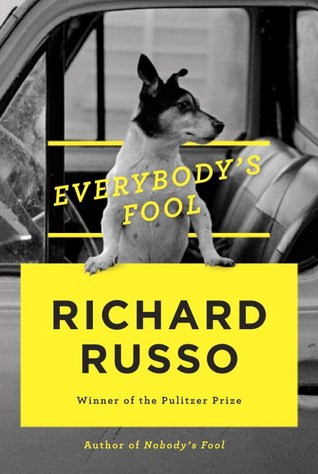
Returning to the Scene
For me in my early 20s, there was no better place to be than on a bar stool next to one of Richard Russo’s characters. Or in a diner swilling thick, black coffee while looking over the daily racing form. Of course, that bar stool and booth are purely metaphorical, but I spent so much time reading Russo’s prose at that age that I feel as though I know his characters — Wild Bill, Harry Saunders, Sam Hall, Sully, Rub —intimately.
It’s why I got so excited when I learned that there would be a sequel to his 1993 novel Nobody’s Fool (Random House). Many may know the story from the film adaptation starring Paul Newman, Jessica Tandy, and Philip Seymour Hoffman (you can see here why a sequel will be impossible to pull off).
With the bulk of the story taking place over 48 hours, and with a healthy dose of digression and flashback,Everybody’s Fool (Knopf) picks up years after the action in Nobody’s Fool. Russo is a master at creating a sense of place and sets his saga again in the familiar North Bath of upstate New York — his Yoknapatawpha County, his Winesburg, Ohio. The lovable and unlucky Sully has had a change in fortune, his finances having risen with the tide, while his friendly adversary Carl Roebuck’s luck is on the skids. A character late in the book seems to speak for these two, and all the snakebit citizens of Bath: “You ever wonder how come some people have all the luck?” Her partner thinks to himself, ” … that was like wondering why the sky was blue. It just was.”
A side character in Nobody’s Fool, police officer Douglas Raymer, takes a turn at leading man and antihero inEverybody’s Fool. Last seen being dressed down by his superiors for discharging his service revolver on a residential street (at Sully, no less), he is now chief of police for Bath. It’s his plight as much as any of the other characters’ that mirrors that of the town (the natural springs have dried up, and it’s losing face to neighboring, tony Schuyler Springs). He’s at the apex of his career, elected to an office of respect, yet is consumed with whom his late wife was sleeping with, whether or not Officer Charice Bond is as in love with him as he is with her, and whether or not he should resign from his position.
Twenty years on from when I first began reading Russo, a lot of water has gone under the bridge. The world has become increasingly smaller and the tragedies of it more readily accessible, so that a storyteller today might feel the need to emphasize the violence and ugliness of their fictional world to hold a reader’s attention. The water in Bath has run cold. While it’s cozy, if not cursed, a darkness has fallen on the streets and seeps into Russo’s story in a way that wasn’t there in 1993. The Rust-Belt town was never a Disneyland by any means, but the stain of violence was simply touched upon, what happened behind closed doors an underlying motive for the psyche of the characters. Today, that stain is unwashable and the violence in-your-face. It can be difficult to read, but read we do because Russo also knows justice and how to deliver it.
For some of us, the characters in a book don’t go away once we’ve finished reading. It’s that extra thump of the heart you get when Kurt Vonnegut’s Eliot Rosewater makes cameo appearances in Slaughterhouse-Five,Breakfast of Champions, and Hocus Pocus, in addition to his own eponymous novel. By the conclusion of a novel, we’ve spent hours in a fictional world that continues on even after THE END, and its people — Pip, Holden, Scout, Almásy — swirl all around us.
It’s why we like sequels. Closure isn’t necessarily what we crave from a story, but continuance. And so it is with Russo and his Sully, Douglas Raymer, Carl Roebuck, and Rub Squeers. Where have they been all this time? What have they been up to? Why, they’ve been right here all along, acting like fools.
